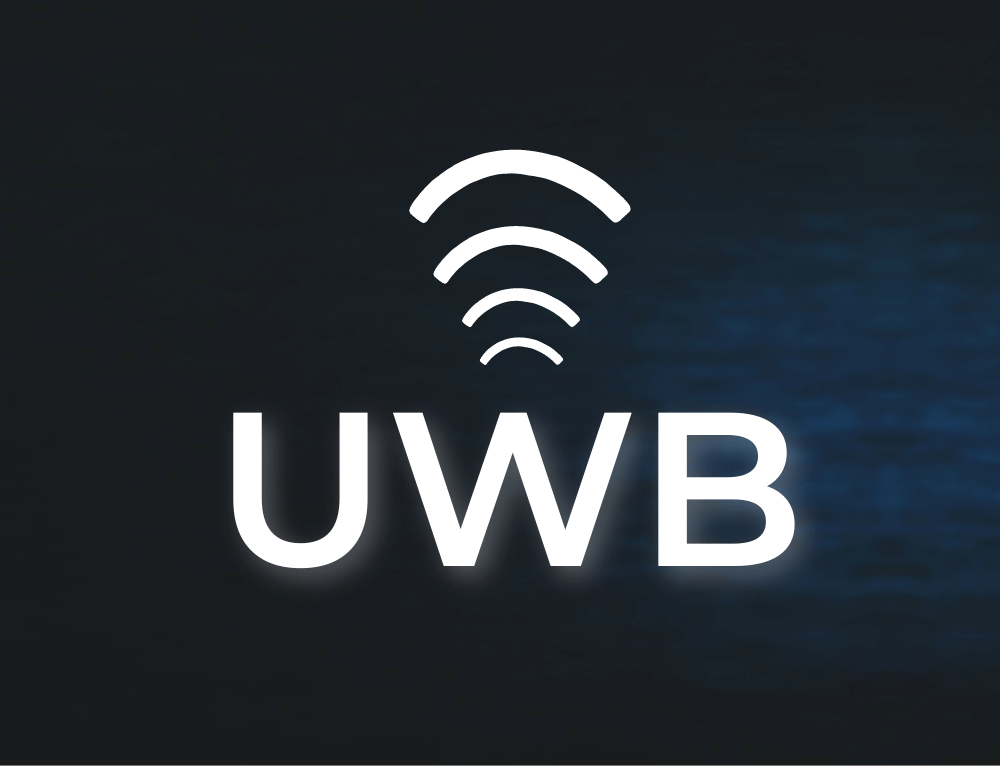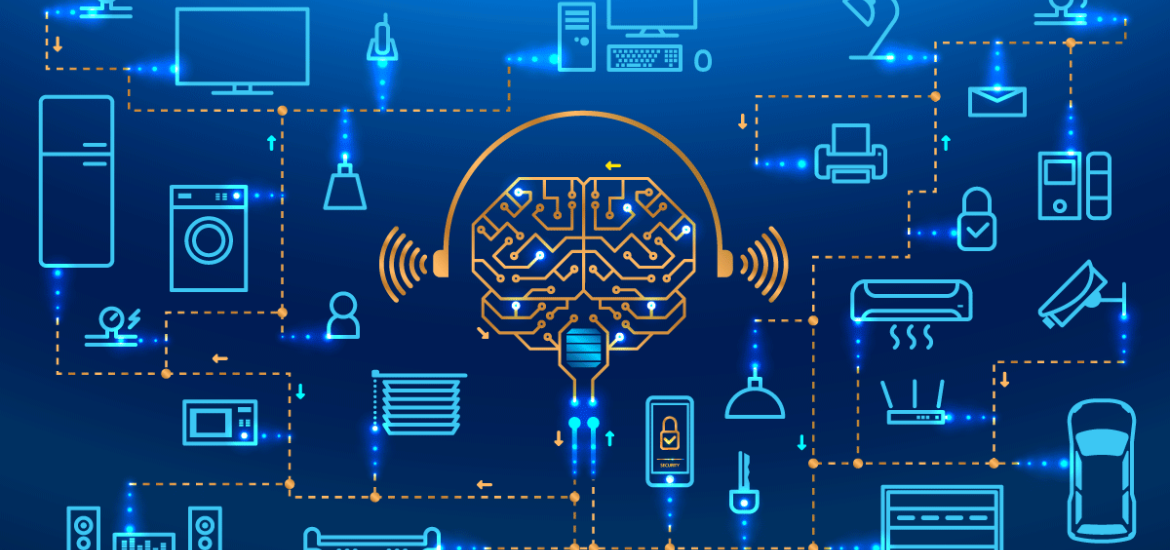
Ultra-wideband, also known as UWB or as digital pulse wireless
Definition
- Ultra wideband is a wireless technology for short-range radio communication, involving the intentional generation and transmission of radio-frequency energy that spreads over a very large frequency range, which may overlap several frequency bands allocated to radio communication services. it broadcasts digital pulses that are timed very precisely on a carrier signal across a very wide spectrum (number of frequency channels) at the same time.
- Ultra-wideband was formerly known as pulse radio, but the FCC and the International Telecommunication Union Radio communication Sector (ITU-R) currently define UWB as an antenna transmission for which emitted signal bandwidth exceeds the lesser of 500 MHz or 20% of the central frequency.
- UWB radio not only can carry a huge amount of data over a distance up to 230 feet at very low power (less than 0.5 milliwatts), but has the ability to carry signals through doors and other obstacles that tend to reflect signals at more limited bandwidths and a higher power.
- UWB can be compared with another short-distance wireless technology, Bluetooth, which is a standard for connecting handheld wireless devices with other similar devices and with desktop computers.
General characteristics
- High data rate
Devices using UWB technology may operate at very low power levels and can support applications involving multiple users at high data rates (e.g. short-range wireless personal area networks (WPANs) at data rates greater than 100 Mbit/s).
- Secure communications
UWB signals are potentially more covert and potentially harder to detect than non-UWB radiocommunication signals. This is because UWB signals occupy a large bandwidth, can be made noise-like, and can communicate with a unique randomizing timing code at millions of bits/s.
- Robust communications
Devices using UWB technology are generally designed to have large processing gain, a measure of a device’s robustness against interference.
- Potential high-density use
UWB technology can potentially be integrated into many applications that could offer benefits to the public, consumers, businesses, and industries. For example, UWB could be integrated into applications for improved public safety with vehicular radar devices for collision avoidance, airbag activation and road sensors, short-range high data rate communication devices, tagging devices, liquid level detectors and sensors, surveillance devices, location determination devices, and as a replacement for wired high data rate connections over short distances. Though most devices using UWB technology would operate at very low power, the many potential UWB applications could result in high density of devices using UWB technology in certain environments such as office and business cores.
- Multipath effects
A wide transmission bandwidth (BW) is needed to overcome multipath fading in an indoor environment.UWB communication devices are therefore resistant to multipath fading in an indoor environment because they have a wide transmission bandwidth and closely spaced multipath components can therefore be resolved in the receiver.
- Imaging and location capabilities
UWB transmissions can penetrate walls and obstacles and provide high accuracy location determination. These properties can also be useful in applications to detect the movement of persons and objects.
UWB Applications
It is known that the UWB pulse is generated in a very short period (sub-Nano second). Therefore, it has spectrum below the allowed noise level. This feature makes it possible to get Gbps speed by using 10GHZ spectrum. So UWB is suitable to be used for high-speed over short distances. Such “noise-like” feature relies on ultra-short waveforms and does not require IF processing because they can be operated at baseband. This UWB feature has long been appreciated as key advantages for medical engineering.
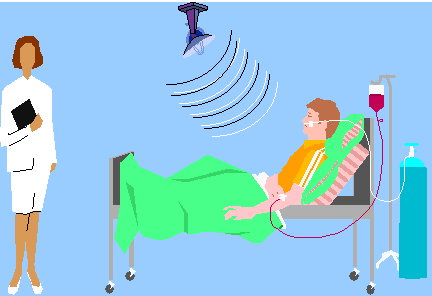
Because of the highly intense pulses used in UWB technology, it is possible to use UWB radar in medical field for remote monitoring and measuring the patients' motion in short distance. This monitoring function could be applied in intensive care units, emergency rooms, home health care, pediatric clinics (to alert for the Sudden Infant Death Syndrome, SIDS), rescue operations (to look for some heart beating under ruins, or soil, or snow). The figure above show the using of UWB in monitoring the patient in intensive care unit could avoid usage of too many wires around the patient.
signals emitting from UWB radars setting on ceiling can reflect when they meet human body. When the patient moves, the reflected signals will fluctuate. The fluctuation of signals denoting the movement of objects is transferred to the control center of the surveillant. The information could be fed back instantaneously to the doctors or nurses. It could also be recorded and analyzed in the future for the health condition of the patient.
In fact, the UWB-enabled sensors could not only detect these macro movements, it could also detect micro movement inside human body. For example, the capability of non-invasive sensing of vital parameters such as respiration system of human body is important and useful in medical engineering. The UWB monitoring of respiratory movement in emergency rooms or intensive care units will be attractive and save much cost especially for large-scale hospitals. Some other typical vital sign monitoring application of UWB include the Cardiology system, Pneumology system, Neurology system and etc. Also The UWB radar can also be used for guarding the medicine storage room.
- Cardiology Imaging
The first applications using UWB radar technology was for heart monitoring since the heart related research has a high impact on general public.
UWB transmitter emits discrete pulses to the human body and the reflected pulses from the heart arrived at UWB receiver and then the result is recorded. Signal processing is performed through obtaining the pulses response. For example, there exists a definite difference in reflection magnitude between the heart muscle and the blood when detecting the heart wall by UWB radar. Because of the impedance difference between the cardiac muscle and blood, a roughly 10% reflection magnitude of the radio frequency energy at the heart muscle-blood boundary can be expected. The UWB receiver can measure the difference, and show it on the screen, which reflects the status of heart.
- Pneumology Imaging
Similar with the Cardiology imaging, the same rule can be found for reflection at chest/lung interface, air/chest interface, and at vessel boundaries. All of them could be imaged by adjusting the emitting pulse power.
With UWB medical imaging system, we could monitor the respiratory patterns, the Apnea monitoring in infants, obstructive sleep apnea monitoring, Polysomnography (sleep related studies), dynamic chest diameters measurement, allergy and asthma crisis monitoring, and chest imaging.
With the UWB dielectric properties, the organic motion-related signal is obtained from a UWB radar device aimed at the human body. Especially for heart as a cardiovascular monitor, the UWB radar could detect cardiac contractions, arterial wall motion and a breath monitor to detect respiratory movements. Because the UWB electromagnetic signal is not influenced by clothes or blankets, and the effective range is only a few meters, the use of the UWB radar in cardiac motion evaluation can be an important complement to the electrocardiogram.
- Obstetrics Imaging
However, unfortunately great concern regarding the RF safety in UWB for the newborn exists although everybody think the ultrasound generally is safe. The "emissions" from the device make this concern a "fear generating" situation. Obviously, more time is needed for everyone could accept the UWB radar. In the future, UWB radar device for obstetrics will be very useful and might be produced in large scale sales.
Actually UWB radar emission is safe and the system is well suited for chronically positioned equipments to monitor the last period of pregnancy or to assist in evaluating labor progress. UWB radar in this application area has many advantages over current ultrasound based fetal monitoring system. These new features include: no contact with patient, unimpaired mother and child care, remote operation, no cleaning and easier use.
- Ear-Nose-Throat Imaging
UWB could also be applied in monitoring and imaging in the Ear-Nose-Throat organs. A typical application is the medical application of the throat microphone which is a device that could monitor vocal chords movement by means of UWB radar.
In a word, UWB applications in medical imaging constitute a very important part of the medical applications of UWB. More different medical equipments will be invented and developed in the near future addressing different parts of human body. With the interaction model of RF wave to human tissue being more completed and mature, the medical imaging equipments using UWB will become more popular, and will be well accepted by everybody.
-An authoritative scientific model of UWB pulse interaction with the living tissues is required before people could accept this new technology and deem it as a safe technology. UWB echos coming from the tissues and structures of the human body are mainly explained in the framework of the Time Domain Reflectometry (TDR) theory . However, in the future, it is also possible for the UWB echo to be interpreted and explained in the frequency domain. Many reasearches are being carried out in this area, and the interaction model need to be set up and refined in the future.
Future research studies in the medical domain to correlate UWB include:
• Ultrasound heart M-Mode tracings.
• External phonocardiogram and apexcardiogram tracings.
• External ballistocardiogram tracings.
• Invasive pressure pulse recordings.
• Electrocardiogram recordings.
• Better understanding and modeling of RF pulse propagation in the living tissues
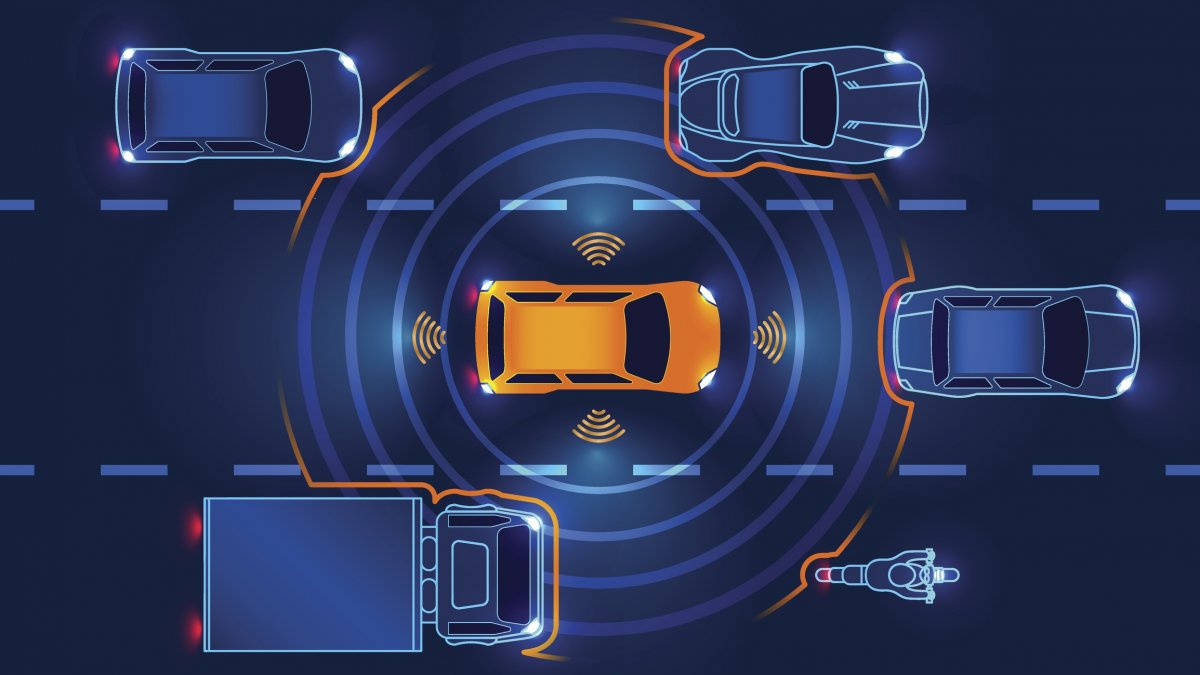
UWB at the Intersection of Vehicle, Mobile and Consumer Devices
Many application of UWB has been used , in the Automotive domain, such as:
- UWB enable the unlocking and starting of a car with a smartphone as well as the secure sharing of vehicle access with other mobile devices.
- Smart car access and Car Connectivity
- Secure hand free access
- Vehicule traking
Indoor tracking in industrial environments often requires very precise localization. For this purpose multiple technologies offer solutions based on the short-range radio technology Ultra-wideband (UWB). It does not work with consumer standards such as Wi-Fi and Bluetooth Low Energy, but offers an accuracy better than 30 cm.
Indoor positioning with Ultra-wideband has some significant advantages: The accuracy is 10-30 cm, which is considerably better than when working with beacons (1-3 meters) or Wi-Fi (5-15 meters). Latency time is very low (position request up to 100 times/second). Height differences can be measured accurately. However, the technique is a special solution which requires appropriate components and thus is mostly suitable for special industry applications.
In sep 2019,Apple launched the first three phones with ultra-wideband capabilities , namely, the iPhone 11, iPhone 11 Pro, and iPhone 11 Pro Max. Apple also launched Series 6 of Apple Watch in September 2020, which features UWB,and their AirTags featuring this technology was revealed at a press event on April 20, 2021.
Devices equipped with the Apple-designed U1 chip have Ultra Wideband technology for spatial awareness. Learn which iPhone models and which countries and regions support Ultra Wideband.
Ultra Wideband is available on iPhone 11, iPhone 12, and iPhone 13 models. Ultra Wideband isn't available in all countries or regions and is subject to international regulatory requirements that require it to be turned off in certain locations.

What can Apple's U1 chip do?
AirDrop
Apple's describes the U1 as a basis of Apple's updated directional version of AirDrop, which can determine where you're pointing your phone when you're trying to share files. "Think GPS at the scale of your living room," Apple explained. "So if you want to share a file with someone using AirDrop, just point your iPhone at theirs and they’ll be first on the list."
Locating tracking
The U1 chip uses ultra-wideband technology for "spatial awareness" - or so the iPhone 11 or 12 can locate other U1-equipped Apple devices. "It's like adding another sense to iPhone," Apple explained at the iPhone 11 launch.
Apple AirTags and Precision Finding
Apple has put the U1 chip into the new AirTag, announced in April 2021, so you can use ultra-wideband between your iPhone and the AirTag to find them.
When you lose an item with an AirTag attached, like your keys for example, you'll be able to use the Find My app to precisely locate the item. You'll get directional instructions on your phone display to guide you to the right place - a system Apple is calling Precision Finding.
UWB is set to unlock a whole range of new consumer and enterprise applications. It has already been incorporated in Samsung’s Galaxy S21+ and S21 Ultra 5G and is now in the new Galaxy Z Fold3 5G and the Samsung Galaxy SmartTag+. It is also likely to feature on a wider array of computing devices and internet of things (IoT) peripherals.
The FiRa Consortium was founded in August 2019 to develop interoperable UWB ecosystems including mobile phones. Samsung, Xiaomi, Oppo are currently members of the FiRa Consortium. In November 2020, Android Open Source Project received first patches related to an upcoming UWB API; feature-complete UWB support is expected in later versions of Android.
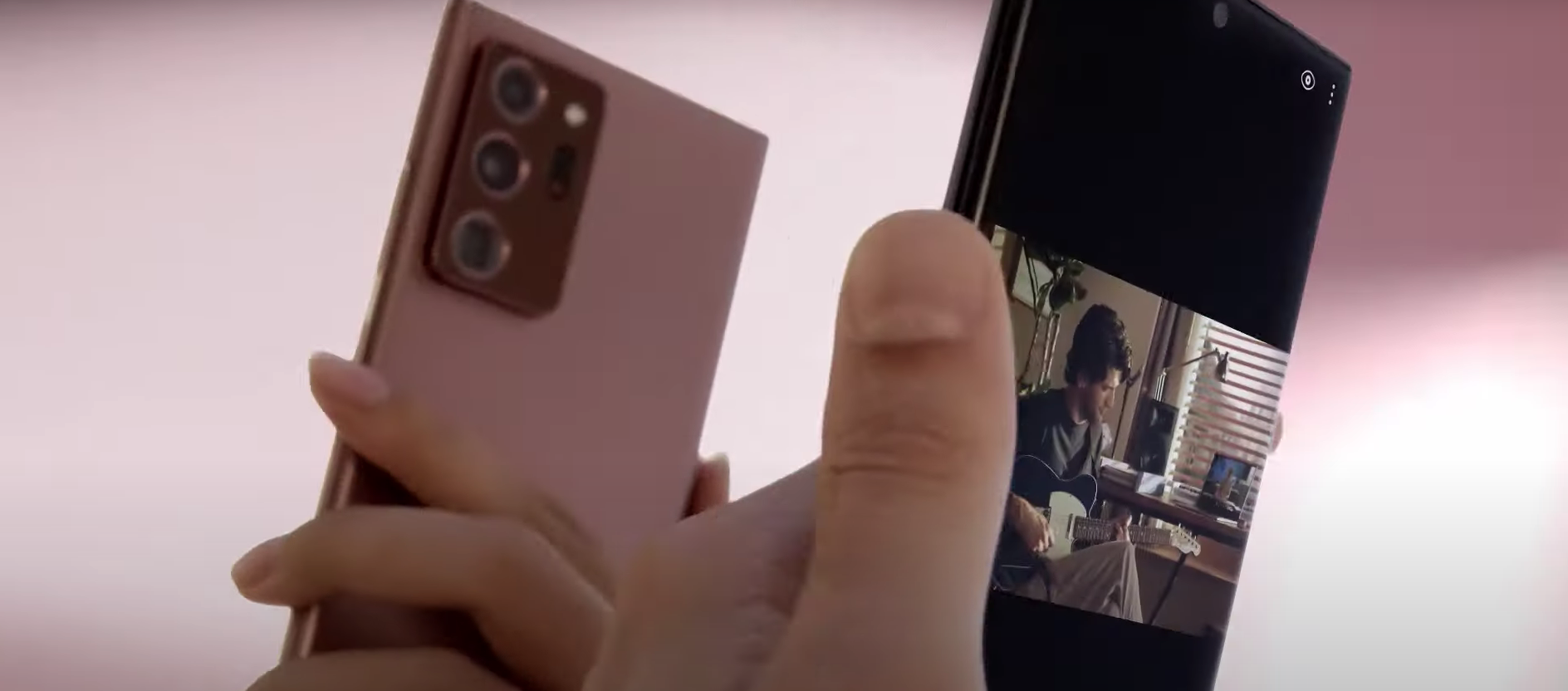
- The unique applications of UWB systems in different scenarios have initially drawn much attention, since many applications of UWB spans around existing market needs for high data rata applications. Demand for high density multimedia applications is increasing, which needs innovative methods to better utilize the available bandwidth. UWB system has the property to fill the available bandwidth as demand increases. The problem of designing receiver and robustness against jamming are main challenges for high-rate applications. The large high-resolution video screens can benefit from UWB. These devices stream video content wirelessly from video source to a wall-mounted screen. Various high data rata applications include internet access and multimedia services, wireless peripheral interfaces and location based services.
- Regardless of the environment, very high data rate applications(>1 Gbit/sec) have to be provided. The use of very large bandwidth at lower spectral efficiency has designated UWB system as a suitable candidate for high internet access and multimedia applications. The conventional narrowband system with high spectral efficiency may not be suitable for low cost and low power devices such as PDA or other handheld devices. Standardized wireless interconnection is highly desirable to replace cables and propriety plugs.The interconnectivity of various numbers of devices such as laptops and mobile phones is increasingly important for battery-powered devices.
- Main application areas include:
• Internet Access and Multimedia Services : Regardless of the envisioned environment (home, office, hot spot), very high data rates (> 1 Gbit/s) have to be provided – either due to high peak data rates, high numbers of users, or both.
• Wireless peripheral interfaces: A growing number of devices (laptop, mobile phone, PDA, headset, etc.) are employed by users to organize themselves in their daily life. The required data exchange is expected to happen as conveniently as possible or even automatically.
Standardized wireless interconnection is highly desirable to replace cables and proprietary plugs. It has to be emphasized, however, that wireless solutions in this context will be attractive mainly for battery-powered devices without the need for an external power supply.
• Location based services : To supply the user with the information he/she currently needs, at any place and any
time (e.g. location aware services in museums or at exhibitions), the users’ position has to be accurately measured. UWB techniques may be used to accommodate positioning techniques and data transmission in a single system for indoor and outdoor operation.
The adoption of UWB within Industry 4.0 is increasing exponentially and the inception of omlox – the world’s first open locating standard – has propelled it to new heights. While UWB is a groundbreaking technology on its own, it truly shines in combination with other locating technologies.
Using UWB causes advancing updates of the UWB rulesets in the United States and Europe, and progressing the global ruleset and spectrum management harmonization. the UWB technology provide cost-efficient, real-time locating services within different industries, in an open and interoperable manner.
Managers of industrial facilities, such as warehouses, factories, and distribution centers are increasingly realizing the added-value that UWB installations would bring to their operations as they aim to transition to smart manufacturing. Having an extremely accurate overview of where assets are located in real-time is paramount to maximizing efficiencies, streamlining processes, reducing costs, and increasing revenues. For this reason, the subpar accuracy of other locating technologies such as Wi-Fi and Bluetooth is not a reliable option.
Industrial facilities are often fast-paced, crowded environments that are spatially complex. Once UWB hardware has been installed and setup in a facility, any and all assets (such as forklifts, palettes, tools, AGVs, or people) may be equipped and tracked with tags. To tackle the challenging, dynamic nature of industrial facilities, UWB signals can pass through a variety of obstacles (including walls and people) and are less susceptible to interference from metallic objects. UWB tags can also be configured to send location updates at an extremely frequent interval, thereby increasing accuracy and reliability.
UWB is still a relatively new player in industrial applications. Companies making the transition to the technology as early adopters will serve as pioneers, while the rest of the industry will lag behind and eventually catch up. “UWB is one of the biggest trends in indoor-locating technology. With UWB we are able to provide indoor-locating solutions with the highest accuracy and robustness especially in harsh industrial environments and under non line of sight conditions. Therefore UWB helps us to develop the best solutions for use cases for the industry.” Daniel Bossert, Head of Customer Projects, TRUMPF Werkzeugmaschinen.

How can we leverage UWB technology?
With its fine precision, fast transmission and high reliability, UWB technology is poised to help companies locate people and objects moving in all sorts of environments and processes.
One highly relevant use case in today’s workforce is social distancing. As organizations return to the workplace safely and securely, they also still need to consider physical distancing guidelines. With UWB technology, a wearable sensor could alert an employee when they get too close to someone.
For any organization involved in manufacturing, UWB could be an essential part of digitizing production and logistics. Now, people and items don’t need to be stationary to be recorded; they can also be mobile. UWB could help seamlessly digitize warehouses, shop floors and process chains, stabilizing internal processes and optimizing productivity.
**In addition to ease-of-use and unprecedented location capabilities, here are three compelling reasons to believe UWB is a game-changing connectivity technology:
-Big brands recognize the technology’s potential: flagship smartphones and vehicles showcase UWB
-Standardization is underway
-It comes with built-in trustworthiness
